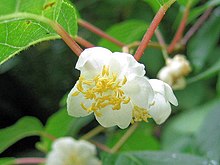Matatabi
| Actinidia polygama | |
|---|---|
 |
|
| Scientific classification | |
| Kingdom: | Plantae |
| (unranked): | Angiosperms |
| (unranked): | Eudicots |
| (unranked): | Asterids |
| Order: | Ericales |
| Family: | Actinidiaceae |
| Genus: | Actinidia |
| Species: | A. polygama |
| Binomial name | |
|
Actinidia polygama |
|
Actinidia polygama (also known as silver vine and cat powder) is a nontoxic plant in the Actinidiaceae family. It grows in the mountainous areas of Japan and China at elevations between 500 and 1900 m.
Silver vine can reach up to 5–6 m high at maturity. It is a deciduous climber and is frost tender. The petiole leaves are silver and white in color and 6–13 cm long and 4–9 cm wide. These colorful markings make the plant identifiable from afar, until the flowering season when the leaves turn completely green.
The flowering season lasts from late June to early July, in which the plant bears white flowers about 2.5 cm in diameter. The longevity of an individual flower is 2–3 d, when the plant also starts to develop small, yellow to yellow-red, egg-shaped, fleshy, and multiseeded fruits, which mature from September to October. The fruit is about 1.5 cm wide and 3.0–4.0 cm long. The inside of the fruit resembles the common kiwifruit, but it is orange in color rather than green.
The silver vine plant requires moist, well-drained soil, and partial shade to full sun. This fast-growing vine makes for good cover on a fence or trellis. It is becoming increasingly popular as an edible fruit crop.
Silver vine has been used for its medicinal benefits for centuries. In traditional Chinese and Japanese medicine, it has been used for a wide range of health problems, including:
In Korean Buddhism, silver vine was soaked in traditional Korean sauces and used for diuresis, alleviation of pain, hypertension, genital troubles, and bronchitis.
It is said that:
“Old, weary travelers, (come) back to life to eat the fruit of [silver vine] and then continue their journey”.
The fruit in the “acorn” shape can be salted and eaten raw, fried in oil, added to rice, or mixed with sesame seeds and mayonnaise to top salads. The fruit may also be fermented to make Matatabi sake and miso, a fruit wine, or used to extract the juice. The leaves, buds, and stems can also be ground into a powder or cut, steamed, and seeped to make tea. Adding mint or sugar can give variations in the tea.
Grinding the leaves and stems into a coarser grind than needed for the tea makes Matatabi grass, which is used as bath salts. The vine is used as material for folk crafts, and the sap is collected to make lotions.
...
Wikipedia
